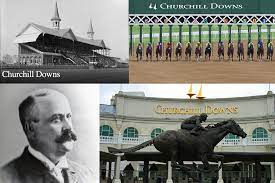Sharpness of Thorns (1875)
The Kentucky Derby, a slice of Americana, presents a kaleidoscope of outlandish hats, frosty mint juleps, and colorful jockey silks. The event’s racetrack, Churchill Downs, hosts what is described as “the greatest two minutes in sports.” Hidden in the spectacle are the namesakes of Churchill Downs: John and Henry Churchill.
In 1773, Armistead Churchill, a descendent of British immigrants, left his native Virginia and, with wife, children, and slaves in tow, headed for Kentucky. His descendants’ social standing and wealth were to make them the First Family of Kentucky.
Another blueblood clan were the Clarks; one of whom, William, was half of the famous Lewis and Clark expedition. His grandson, Meriwether Lewis Clark Jr., bore a blend of both explorers’ names. When Meriwether, (nicknamed Lutie), was six years old, his mother, Abigail Prather Churchill, passed away, and he went to live with his wealthy bachelor uncles, John and Henry, who afforded him a life of luxury. 
In 1872, Lutie visited England where the Earl of Derby’s Epsom Derby inspired him to create a similar race in Kentucky. The concept met with a lukewarm reception as skeptics felt a local track could not compete with New York’s Saratoga. However, Lutie’s massive frame was equal to his massive resolve. He toured the state to raise funds, and with his proceeds of $32,000, ($600,000 in contemporary currency), he leased eighty acres of land from the Churchills.
On the Kentucky Derby’s inaugural day, the grandstands, constructed to seat 2,000 spectators, overflowed with 10,000. The victorious horse, Aristes, memorialized by a bronze statue by the paddock, owner received $2,900 for the victory. Later, the winner would also earn a garland of 554 red roses that led to the Derby’s unofficial name, “Run for the Roses.” The tradition had its genesis when socialite E. Berry Wall handed out the flowers to ladies at a post-Derby luncheon. While the ceremony ends the annual race, the Derby begins with Stephen Foster’s 1852, “My Old Kentucky Home,” the state’s official song. The now controversial lyrics are a slave’s nostalgic longing for his old plantation.
Lutie’s uncontrollable temper ended his marriage and his association with his racetrack. After an argument, breeder T.G. Moore shot Lutie in the chest, an injury from which he recovered. Wealthy New Yorker, James Ben Ali Haggin, boycotted the derby after a disagreement and convinced his friends to do likewise. Profits plummeted, and by 1894, The Louisville Commercial referred to the race as “a contest of dogs.” Facing financial ruin and humiliation, Lutie worked at various tracks. In Chicago, a bartender took offense when Lutie referred to Chicagoans as “thieves and liars.” As matters escalated, Lutie aimed his gun at the man’s chest, and the press covered the barroom brawl. The Churchill brothers disinherited their nephew and stripped him from participation in the racetrack he had willed into existence. Lutie committed suicide in 1899. His family interred him in Cave Hill Cemetery next to John Churchill.
The Kentucky Derby is the oldest continuous sporting event in the United States and attracts 150,000 visitors on the first Saturday in May. In 1952, television carried the event for the first time drawing an audience of ten to fifteen million. The winning purse pays out $3,000,000; the victor receives a 14-karat gold trophy topped with an 18-karat gold horse. Lutie’s Churchill Downs currently generates $1.5 billion annual revenue; in 1968, it became a National Historic Landmark.
The event’s rose holds symbolic overtones for Meriwether Lewis Clark Jr., a combination of the fragrance of its petals and the sharpness of its thorns.


